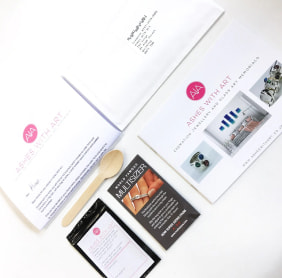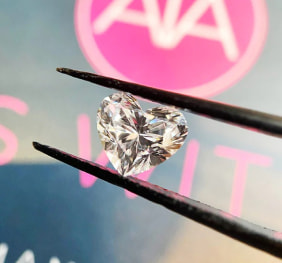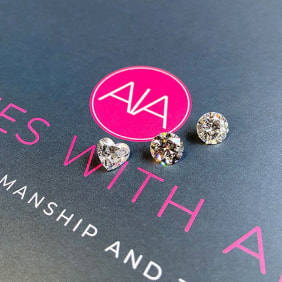Cremation Ashes vs Hair Keepsakes: What’s the Difference?
- ✓ Ashes keepsakes work well for glass art and ash-infused gemstones (or sealed chambers).
- ✓ Hair keepsakes are ideal when the appearance/texture is meaningful—best in lockets or resin (avoid high-heat glass).
- ✓ Only a tiny amount of ashes or hair is needed; any unused material is returned safely.
Creating memorial keepsakes following a death of a loved one can be overwhelming but cathartic. With so many options available, you might fear making the wrong decision about which memorial is right for you.
Two of the most common keepsakes are memorial ashes keepsakes and hair keepsakes. Many people find comfort and reassurance in the idea of keeping a small piece of their loved one close by. It can make things like funerals and scattering the ashes feel less final, and will allow you to keep hold of something significant, while still being able to let go and move forward.
Some memorial keepsakes require cremation ashes, and some are better suited to hair memorials, and some are adaptable to both. In this guide, we’re exploring some of the options available for memorial keepsakes, including ashes and hair memorials. This could help you to select the perfect option that will bring you comfort and reassurance as you go through this important grieving period.
What are memorial keepsakes?
This is a broad term that might apply to a number of different items. The term usually includes items like jewellery, artwork, plush toys, decorations and other keepsakes. The keepsake might include the ashes of the loved one, or it could contain a lock of hair. It’s also common to make items from the individual’s clothing.
This is a popular choice as it helps to provide a physical item that the person can hold close when they are going through the grieving process. It might not be healthy to keep hold of all of their items or to keep the ashes forever, but saying goodbye too soon could also be a mistake.
Creating a memorial keepsake allows for a healthy transition, where the person can allow themselves to continue to grieve, while still following a healthy path to move forward. Over time, they might find that they rely on the keepsake less and less, and it becomes something that they reach for when they want to reminisce about their loved one.
Hair and ashes are a popular choice for adding to a memorial keepsake. Keeping a small part of your loved one with you is highly symbolic, and there is a sense of duty in honouring a loved one in this way. If you can see the hair in the keepsake, this can be particularly moving.
Cremation ashes keepsakes explained
There are many ways to make a keepsake with cremation ashes, these are some of the most popular methods:
Cremation jewellery
There are many options available when it comes to cremation jewellery. You could opt for hidden compartment jewellery, where the ashes are housed in a hidden chamber within the jewellery and then permanently sealed. You could also opt for glass gemstone jewellery, where the ashes are placed in molten glass and then shaped into a gemstone.
Glass keepsakes
Like with the glass gemstones for cremation jewellery, it’s also possible to make larger glass keepsakes such as paperweights, ornaments and decorative pebbles. These can be kept around the house, or perhaps added to seasonal decorations. You could also add a decorative pebble containing cremation ashes into a memorial garden.
Cremation ashes artwork
Memorial artists are often able to add the cremation ashes into the paint they use in order to create a memorial artwork. This could be a commemorative portrait, an abstract piece, or a landscape of a special place. It’s also possible to add cremation ashes to glass and turn this into a wall hanging.
Cremation diamonds
This is perhaps one of the most expensive options available. It’s possible to turn remains into a diamond by applying extreme heat and pressure in a controlled environment. This is more expensive than a diamond is worth, but it’s about the emotional connection to the diamond. Many people prefer to add a lab grown diamond to a piece of hidden compartment jewellery, as this is far more cost effective.
Hair keepsakes explained
Another common memorial choice is to save a lock of hair and add this to various keepsake items. Hair often has a lot of emotional connection. This is also a popular option for pet memorials, as the link we have to their fur is often quite strong.
Popular hair keepsakes include:
Hair keepsake jewellery
Like with memorial ashes, it’s also possible to add hair into a hidden chamber and permanently seal this. If you would like the hair to be visible, you might choose a locket with a glass enclosure that would allow you to see the hair. Glass gemstone keepsakes would not be suitable for hair, since the temperature of the glass would burn the hair. One option, is to include hair by setting it beneath the glass gemstone.
Resin keepsakes
Lock of hair jewellery doesn’t have to be a memorial piece. Some parents will choose to have their child’s first lock of hair preserved in resin in a keepsake or jewellery. It’s also common to use resin for pet and horse memorials, as the resin allows you to suspend the hair in space.
Which is right for me?
Choosing the right memorial keepsake for you can be overwhelming. There is also a sense of urgency to make a decision – after all, you’ll need to decide if you would like a hair keepsake before the cremation happens.
The best approach is to prepare for both and then sit with the decision for a while. You don’t have to decide all at once, and you might find that the right decision becomes obvious to you eventually.
Hair keepsakes are popular for pets and horses, as you’ll often have a strong connection to their fur or the way their mane looks. This is often a defining feature, so you’ll enjoy a far greater connection from this type of keepsake.
You might also opt for a cremation ashes keepsake, as these can help to make the process of burying or scattering the ashes far easier. Saying goodbye in this way could feel very final, so it’s helpful to have a symbolic portion of the ashes to hold on to. You could also create memorial keepsakes for all of the family members, so everyone can travel with a small portion of the remains with them.
How much ashes or hair do you need?
We only use a small portion of the ashes or hair for our keepsake jewellery. If you choose to have a resin memorial keepsake, you’ll need enough of the hair to be visible in the finished piece. Any unused ashes or hair will be kept safe and returned to you. You might choose to bury or scatter these remains, or you might keep them should you decide to make more keepsakes in the future.
Customising your keepsake
In addition to the deeply personal contents of memorial keepsakes, it’s also possible to further personalise these items with engravings or inscriptions. You could have these etched with their handwriting or even a fingerprint.
This will help to further customise the piece and give you something meaningful to reach for when you are grieving your loss. For ideas, see engraving ideas & quotes.
Ashes vs Hair: quick comparison
| Option | Best for | Highlights | Considerations |
|---|---|---|---|
| Ashes keepsakes | Sharing among family; glass & gemstone settings | Glass art and ash-infused gemstones; easy to create matching pieces | Small pinch of ash required; look depends on colour/setting |
| Hair keepsakes | Visible, tactile remembrance (locks, pet fur, horse mane) | Highly personal when visible in locket/resin; no cremation required | Avoid high-heat glass; plan ahead to collect hair |





